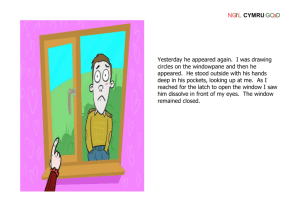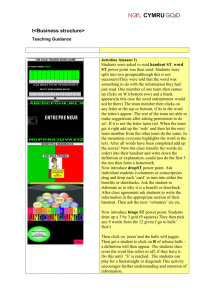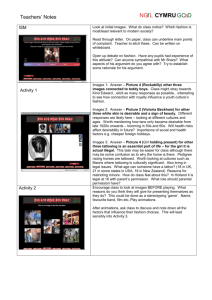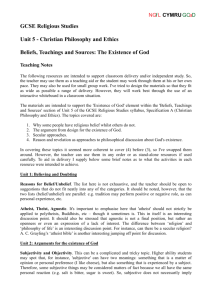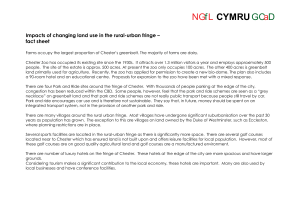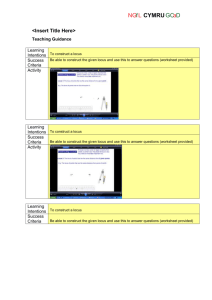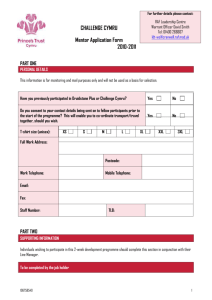5.1.Women and WW1
advertisement
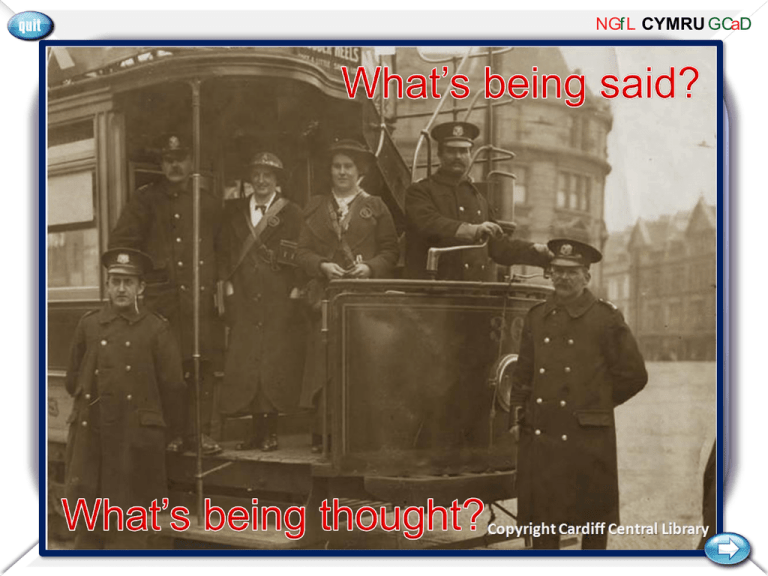
NGf L CYMRU GCaD NGf L CYMRU GCaD Advance to next slide Source A Advance to source material Click for help End PPT NGf L CYMRU GCaD Write descriptions of differing interpretations of the advances of women during the First World War. What I’m Looking For Give an explanation of why different historical interpretations might be produced. Click to reveal Use appropriate dates and historical terms. Suitably structure your work. NGf L CYMRU GCaD Click to reveal Click to reveal Source A Source B CYMRU GCaD When was the source written? What might have influenced the author? Who is the author? What do they do? Describe the interpretation. What does the source tell me about women during WW1? NGf L During the First World War women's work and status began to change. Women were actively recruited to do war work and many others volunteered … At the end of the war it was clear that women and their work had been vital to the war effort. [From the education section of the Imperial War Museum website, www.iwm.org.uk looking at women’s lives in the 20th and 21st centuries (2008)] Source A What evidence may have been looked at and how might this explain how the interpretation was produced? Source B Describe the interpretation. What does the source tell me about women during WW1? NGf L CYMRU GCaD When was the source written? What might have influenced the author? Who is the author? What do they do? Throughout the war … most male-dominated professions remained closed to women. Even in areas where they were employed in large numbers, such as munitions and transport, they were often treated as inferior, stop-gap replacements for enlisted men. Moreover, women's wages, routinely portrayed as 'high' in the wartime press, remained significantly lower than those of their male counterparts. [From the commentary to the BBC TV documentary series Out of the Doll’s House, which looked at the history of women in the twentieth century (1988)] Source A What evidence may have been looked at and how might this explain how the interpretation was produced? Source B Describe the interpretation. What does the source tell me about womenNGf during the war?GCaD L CYMRU Help! Source A During the First World War women's work and status began to change. Women were actively recruited to do war work and many others volunteered … At the end of the war it was clear that women and their work had been vital to the war effort. NGf L CYMRU GCaD Click to check answers Most women in domestic service Most women in domestic service Most women in domestic service Work in munitions factories Work in munitions factories Work in munitions factories Married women not expected to work Married women not expected to work Married women not expected to work Women campaigned for the vote Women campaigned for the vote Women campaigned for the vote Women were paid less than men Women were paid less than men Women were paid less than men Women took on ‘male only ’ jobs Women took on ‘male only ’ jobs Women took on ‘male only ’ jobs Women joined the Land Army Women joined the Land Army Women joined the Land Army Many men saw women as inferior Many men saw women as inferior Many men saw women as inferior Women joined the armed forces Women joined the armed forces Women joined the armed forces Women were nurses Women were nurses Women were nurses Click the arrows to move the statements under the correct heading Describe the interpretation. What does the source tell me about women during war? GCaD NGf Lthe CYMRU Read the information below to try and help you understand a little more about the work of women during the First World War. As men left their jobs to volunteer to fight for King and country, they were replaced by women. As a result the number of women employed increased from 3,224,600 in July, 1914 to 4,814,600 in January 1918. Women took up roles in government departments, became clerical workers, worked as conductors on trams and buses, worked on the land, in the munitions industry, did heavy work such as unloading coal, stoking furnaces and building ships. Women also served as non-combatants in the Women's Royal Navy Service (WRNS), Women's Army Auxiliary Corps (WAAC) and Women's Royal Air Force (WRAF). Others became nurses or joined the Voluntary Aid Detachments (V.A.D.). Female bus conductors on a tramcar in Cardiff Source: Cardiff Central Library Who is the author? What do they do? Help! NGf L CYMRU GCaD [From the education section of the Imperial War Museum website, www.iwm.org.uk looking at women’s lives in the 20th and 21st centuries (2008)] Education Section Designed to provide materials for school Children and therefore might lead to resources but in this case it is produced by a knowledgeable author. being more generalised and less specific. Imperial War Museum Designed to provide materials for school children A museum devoted to Britain’s and therefore might lead to resources being more involvement armed conflicts. generalisedin and less specific. Website Might be untrustworthy as anyone can produce a website, Might beA untrustworthy as anyone can produce a website, museum devoted to Britain’s but in this case it is produced by a knowledgeable involvement in armed conflicts. author. Click the tabs to match the terms on the left with an explanation on the right. Source A Answers NGf L CYMRU GCaD When was the source written? What might have influenced the author? Help! [From the education section of the Imperial War Museum website, www.iwm.org.uk looking at women’s lives in the 20th and 21st centuries (2008)] Views given would be based on the most up-to-date evidence. Facts would be distorted to just show one-side of the argument. Would make it primary source and reflect one person’s opinion. The museum was looking to make children more aware of the role of women during the two World Wars. The Imperial War Museum was recognised for its accuracy and had a good reputation. More objective accounts are produced as this is long after the events. Source A Answers Click on the tabs to change to the correct colour. What evidence may have been looked at and how might this explain how the interpretation was produced? NGf L CYMRU GCaD [From the education section of the Imperial War Museum website, www.iwm.org.uk looking at women’s lives in the 20th and 21st centuries (2008)] The views of many historians. Official records that were available. Those in charge of the various collections are archivists and historians who read widely. The Government has a 30 year rule on evidence but does not need to release everything. Accounts given by women who worked during the war. Account of men who served with women during the war. Source A Click on the statements that you believe to be true. The museum has many records from diaries to interviews. The museum has many records from diaries to interviews. Describe the interpretation. What does the source tell me about women during war? GCaD NGf Lthe CYMRU Help! Throughout the war … most male-dominated professions remained closed to women. Even in areas where they were employed in large numbers, such as munitions and transport, they were often treated as inferior, stop-gap replacements for enlisted men. Moreover, women's wages, routinely portrayed as 'high' in the wartime press, remained significantly lower than those of their male counterparts. What evidence is used by the writer to support their view? Source B NGf L CYMRU GCaD Number of women in work increased by 1.6 m Number of women in work increased by 1.6 m Number of women in work increased by 1.6 m 700,000 worked in munitions factories 700,000 worked in munitions factories 700,000 worked in munitions factories Women became bus and tram conductors Women became bus and tram conductors Women became bus and tram conductors Employers ensured women were paid less than men Employers ensured women were paid less than men Employers ensured women were paid less than men More women joined trade unions More women joined trade unions More women joined trade unions The government had to persuade the Unions to allow women in to the factories The government had to persuade the Unions to allow women in to the factories The government had to persuade the Unions to allow women in to the factories 23,000 women joined the Land Army 23,000 women joined the Land Army 23,000 women joined the Land Army Women joined the armed forces in non-combat roles Women joined the armed forces in non-combat roles Women joined the armed forces in non-combat roles Women over 30 got the vote in 1918 Women over 30 got the vote in 1918 Women over 30 got the vote in 1918 At the end of the war women were forced out of jobs At the end of the war women were forced out of jobs At the end of the war women were forced out of jobs Read the statements and decide how much actually changed for women Who is the author? What do they do? Help! NGf L CYMRU GCaD [From the commentary to the BBC TV documentary series Out of the Doll’s House, which looked at the history of women in the twentieth century (1988)] BBC TV well respected organisation that is known for AATV programme intended to present opinions Producing well-researched programmes. on past or present events by interviewing people. Documentary A TV programme concentrated the lives A TV programmethat intended to presenton opinions th on past presentduring events the by interviewing people. ofor women 20 century. Out of the Doll’s House well respected that organisation that ison known for AATV programme concentrated the lives th century. Producing of women well-researched during the 20programmes. Click the tabs to match the terms on the left with an explanation on the right. Source B Answers NGf L CYMRU GCaD When was the source written? What might have influenced the author? Help! [From the commentary to the BBC TV documentary series Out of the Doll’s House, which looked at the history of women in the twentieth century (1988)] Produced as women were still treated poorly in Britain. Written a long time after the events so was less emotive. Written over eighty years after the events so is less reliable. Produced at a time when people were aware of the long-term impact of the war. Produced when many female historians wanted to show the War affected more than the soldiers. The producers were still able to talk to some women who had worked during the war. Source B Answers Click on the tabs to change to the correct colour. What evidence may have been looked at and how might this explain how the interpretation was produced? NGf L CYMRU GCaD [From the commentary to the BBC TV documentary series Out of the Doll’s House, which looked at the history of women in the twentieth century (1988)] The views of many historians. Official records that were available. Those in charge of the various collections are archivists and historians who read widely. The Government has a 30 year rule on evidence but does not need to release everything. Accounts given by women who worked during the war. Account of men who served with women during the war. Source B Click on the statements that you believe to be true. The museum has many records from diaries to interviews. The museum has many records from diaries to interviews.
